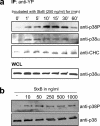The Mitogen-activated protein kinase p38 links Shiga Toxin-dependent signaling and trafficking
- PMID: 17959827
- PMCID: PMC2174185
- DOI: 10.1091/mbc.e07-06-0565
The Mitogen-activated protein kinase p38 links Shiga Toxin-dependent signaling and trafficking
Abstract
Shiga toxin (Stx) binds to the cell, and it is transported via endosomes and the Golgi apparatus to the endoplasmic reticulum and cytosol, where it exerts its toxic effect. We have recently shown that Stx activates the tyrosine kinase Syk, which in turn induces clathrin phosphorylation and up-regulates Stx uptake. Here, we show that toxin-induced signaling can also regulate another step in intracellular Stx transport. We demonstrate that transport of Stx to the Golgi apparatus is dependent on the mitogen-activated protein kinase p38. Treatment of cells with chemical inhibitors or small interfering RNA targeting p38 inhibited Stx transport to the Golgi and reduced Stx toxicity. This p38 dependence is specific to Stx, because transport of the related toxin ricin was not affected by p38 inhibition. Stx rapidly activated p38, and recruited it to early endosomes in a Ca(2+)-dependent manner. Furthermore, agonist-induced oscillations in cytosolic Ca(2+) levels were inhibited upon Stx stimulation, possibly reflecting Stx-dependent local alterations in cytosolic Ca(2+) levels. Intracellular transport of Stx is Ca(2+) dependent, and we provide evidence that Stx activates a signaling cascade involving cross talk between Ca(2+) and p38, to regulate its trafficking to the Golgi apparatus.
Figures







Similar articles
-
Annexin A1 and A2: roles in retrograde trafficking of Shiga toxin.PLoS One. 2012;7(7):e40429. doi: 10.1371/journal.pone.0040429. Epub 2012 Jul 6. PLoS One. 2012. PMID: 22792315 Free PMC article.
-
β-arrestins attenuate p38-mediated endosome to Golgi transport.Cell Microbiol. 2009 May;11(5):796-807. doi: 10.1111/j.1462-5822.2009.01292.x. Epub 2009 Jan 21. Cell Microbiol. 2009. PMID: 19159388
-
Benzyl alcohol induces a reversible fragmentation of the Golgi apparatus and inhibits membrane trafficking between endosomes and the trans-Golgi network.Exp Cell Res. 2017 Aug 1;357(1):67-78. doi: 10.1016/j.yexcr.2017.04.025. Epub 2017 Apr 25. Exp Cell Res. 2017. PMID: 28450044
-
Alternate routes for drug delivery to the cell interior: pathways to the Golgi apparatus and endoplasmic reticulum.Adv Drug Deliv Rev. 2007 Aug 10;59(8):782-97. doi: 10.1016/j.addr.2007.06.006. Epub 2007 Jun 28. Adv Drug Deliv Rev. 2007. PMID: 17669543 Free PMC article. Review.
-
Pathways followed by ricin and Shiga toxin into cells.Histochem Cell Biol. 2002 Feb;117(2):131-41. doi: 10.1007/s00418-001-0346-2. Epub 2001 Nov 20. Histochem Cell Biol. 2002. PMID: 11935289 Review.
Cited by
-
The role of PS 18:0/18:1 in membrane function.Nat Commun. 2019 Jun 21;10(1):2752. doi: 10.1038/s41467-019-10711-1. Nat Commun. 2019. PMID: 31227693 Free PMC article. Review.
-
Mobile effector proteins on phage genomes.Bacteriophage. 2012 Jul 1;2(3):139-148. doi: 10.4161/bact.21658. Bacteriophage. 2012. PMID: 23275865 Free PMC article.
-
Ricin and Shiga toxins: effects on host cell signal transduction.Curr Top Microbiol Immunol. 2012;357:41-65. doi: 10.1007/82_2011_181. Curr Top Microbiol Immunol. 2012. PMID: 22057792 Free PMC article. Review.
-
Activation of the Classical Mitogen-Activated Protein Kinases Is Part of the Shiga Toxin-Induced Ribotoxic Stress Response and May Contribute to Shiga Toxin-Induced Inflammation.Infect Immun. 2015 Oct 19;84(1):138-48. doi: 10.1128/IAI.00977-15. Print 2016 Jan. Infect Immun. 2015. PMID: 26483408 Free PMC article.
-
Phosphorylation of SNX27 by MAPK11/14 links cellular stress-signaling pathways with endocytic recycling.J Cell Biol. 2021 Apr 5;220(4):e202010048. doi: 10.1083/jcb.202010048. J Cell Biol. 2021. PMID: 33605979 Free PMC article.
References
-
- Bencherif M., Eisenhour C. M., Prince R. J., Lippiello P. M., Lukas R. J. The “calcium antagonist” TMB-8 [3,4,5-trimethoxybenzoic acid 8- (diethylamino)octyl ester] is a potent, non-competitive, functional antagonist at diverse nicotinic acetylcholine receptor subtypes. J. Pharmacol. Exp. Ther. 1995;275:1418–1426. - PubMed
-
- Cavalli V., Vilbois F., Corti M., Marcote M. J., Tamura K., Karin M., Arkinstall S., Gruenberg J. The stress-induced MAP kinase p38 regulates endocytic trafficking via the GDI:Rab5 complex. Mol. Cell. 2001;7:421–432. - PubMed
-
- Chao T. S., Byron K. L., Lee K. M., Villereal M., Rosner M. R. Activation of MAP kinases by calcium-dependent and calcium-independent pathways. Stimulation by thapsigargin and epidermal growth factor. J. Biol. Chem. 1992;267:19876–19883. - PubMed
Publication types
MeSH terms
Substances
LinkOut - more resources
Full Text Sources
Miscellaneous

